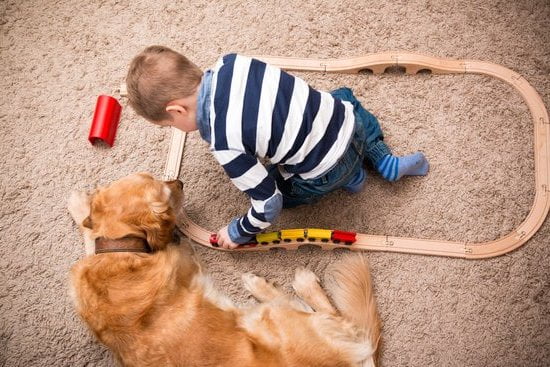How to train a service dog to retrieve: Understanding the role of a service dog is crucial in their training process. Service dogs play an essential role in assisting individuals with disabilities, providing support, and improving their quality of life.
From guiding the visually impaired to alerting individuals with epilepsy of an upcoming seizure, these specially trained dogs offer invaluable assistance. One important skill for a service dog is retrieving, which can be vital in helping their handlers with various tasks.
The ability to retrieve objects is a foundational skill for many service dogs. Whether it be picking up dropped items for someone with limited mobility or fetching medication for someone with a medical condition, retrieving plays a crucial part in the daily lives of those who rely on service dogs. In this article, we will explore the significance of teaching a service dog to retrieve and how it contributes to their role as an invaluable companion.
Before diving into the specifics of training a service dog to retrieve, it’s important to consider the type of dog that is best suited for this specialized work. Not all breeds are suitable for service dog training, and certain traits such as intelligence, temperament, and physical abilities are essential when selecting a potential candidate for this important role.
By understanding the characteristics needed in a service dog, individuals can make informed decisions when finding the right partner for their training journey.
The Importance of Retrieving in Service Dog Training
Retrieving is a crucial skill for service dogs as it allows them to assist their handlers in various ways, such as picking up items, opening doors, and providing physical support. This skill is particularly important for individuals with mobility limitations or disabilities. By being able to retrieve objects, service dogs can enhance the independence and quality of life of their handlers.
In addition to physical assistance, retrieving also serves as a mental stimulation for service dogs. It gives them a sense of purpose and accomplishment, which is essential for their overall well-being. Engaging in retrieving activities can keep service dogs mentally sharp and focused, preventing boredom and other behavioral issues.
When selecting a dog for service dog training, it is important to consider the breed’s natural tendencies and inclinations. Breeds that have a strong retrieving instinct, such as Labrador Retrievers, Golden Retrievers, and German Shepherds, are usually well-suited for this type of work. These breeds are known for their intelligence, willingness to please, and trainability, making them excellent candidates for learning retrieving tasks.
| Service Dog Breed | Retrieving Ability |
|---|---|
| Labrador Retriever | Excellent |
| Golden Retriever | Excellent |
| German Shepherd | Good |
Choosing the Right Dog for Service Dog Training
When it comes to training a service dog to retrieve, choosing the right dog is crucial. Not all dogs are suitable for service dog training, and certain breeds are more inclined to excel in this role. Here are some factors to consider when choosing the right dog for service dog training:
- Temperament: Service dogs need to be calm, obedient, and friendly. It’s important to choose a dog with a temperament that is well-suited for the demands of service work.
- Size: Depending on the specific needs of the individual requiring a service dog, size can be an important consideration. Some tasks may require a larger dog, while others may be better suited for smaller breeds.
- Health: A good candidate for service dog training should be in good overall health with no major medical issues that could affect its ability to perform tasks.
It’s also essential to consider where the dog will be working as a service animal and any specific requirements or restrictions associated with that environment. Additionally, keep in mind that each individual may have unique needs that should be taken into account when selecting the right dog for service training.
Finally, it’s important to remember that every dog is an individual, and breed generalizations should not override an assessment of each individual’s personality and suitability for service work. Once you have found a suitable candidate, you can move on to basic obedience training as the foundation for teaching retrieving commands.
Overall, selecting the right dog is the first step in preparing them for the specific tasks they will need to perform as a valuable service animal.
Basic Obedience Training for Service Dogs
Before a service dog can be trained to retrieve items, it is essential for them to have a solid foundation in basic obedience training. This includes commands such as sit, stay, come, and heel. Basic obedience training lays the groundwork for more advanced skills and behaviors and helps service dogs develop the discipline and focus necessary to perform their duties effectively.
During basic obedience training, it is important to use positive reinforcement techniques such as treats, praise, and playtime to encourage good behavior. Consistency is key in this stage of training, as service dogs need to understand that certain behaviors are always expected of them regardless of the situation. It is also important to start with short training sessions and gradually increase the duration as the dog becomes more skilled and focused.
Service dog handlers should also be aware of the specific needs of their chosen breed when it comes to obedience training. Some breeds may require more repetition and patience, while others may respond better to certain training methods. Understanding the unique characteristics of a particular breed can help ensure successful obedience training for service dogs.
Introduction to Retrieving Commands
When it comes to training a service dog, one of the key skills they need to learn is retrieving. This skill can be crucial in assisting individuals with disabilities or medical conditions. Retrieving commands can enable service dogs to pick up and deliver various items such as medication, phones, or assistive devices. In addition to practical tasks, retrieving can also provide mental stimulation and a sense of purpose for the service dog.
The first step in introducing retrieving commands is establishing a strong foundation in basic obedience training. This includes commands such as sit, stay, come, and heel. A service dog should have a solid understanding of these basic commands before moving on to more complex tasks like retrieving. Once the basics are mastered, the trainer can introduce specific retrieving commands such as “fetch,” “take it,” and “give.” Consistency and patience are key when teaching these new commands.
It’s important for trainers to recognize that not all dogs are suitable for service dog training. The right candidate should possess attributes such as intelligence, sociability, and willingness to please. Different breeds may excel in different tasks, so choosing the right dog for service dog training is essential in ensuring success in teaching retrieving commands. By carefully selecting the right candidate and following a structured training program, individuals can successfully train their service dogs to perform helpful retrieving tasks.
| Aspect | Description |
|---|---|
| Service Dog Skills | Retrieving is a crucial skill for assisting individuals with disabilities or medical conditions |
| Obedience Training | Basic obedience training is necessary before introducing retrieving commands |
| Dog Selection | Choosing the right candidate for service dog training is crucial for success |
Step-by-Step Guide to Teaching a Service Dog to Retrieve
Introduction to Retrieving Commands
Before beginning the actual training, it is important to introduce your service dog to the basic retrieving commands. These commands include “fetch”, “take it”, “hold”, and “drop it”. It is essential that your service dog understands these commands before moving on to the actual retrieval training.
Step 1: Building a Solid Foundation
The first step in teaching a service dog to retrieve is to build a solid foundation of obedience and trust. Your dog should be well-versed in basic obedience commands such as sit, stay, and come before starting the specific retrieving training. This will create a strong bond between you and your dog, making the training process much smoother.
Step 2: Introducing the Object
Once your dog has a good grasp of basic obedience commands, introduce the object you want them to retrieve. Start with an object that your dog is familiar with, such as their favorite toy. Use positive reinforcement techniques such as treats and praise to encourage them to interact with the object.
Step 3: Gradual Training Process
Gradually increase the difficulty of the retrieval tasks, starting from short distances and eventually working up to longer distances. Be patient with your dog and provide plenty of rewards and encouragement when they successfully retrieve an object. Consistency is key in this training process, so be sure to practice retrieving commands regularly.
Advanced Retrieving Techniques for Service Dogs
Introducing Distractions
Once your service dog has mastered the basic retrieving commands, it’s important to expose them to various distractions. This can include being around other animals, loud noises, or crowded environments. By gradually introducing distractions during retrieving training, you can ensure that your service dog remains focused and responsive in any situation.
Expanding Retrieving Tasks
As your service dog becomes more proficient in retrieving, you can start expanding the tasks they perform. This could include fetching items from different rooms, learning to close doors after retrieving an item, or even assisting with tasks such as picking up dropped objects for their handler. By continually challenging and expanding the retrieving tasks, you can provide mental stimulation for your service dog while also increasing their usefulness in day-to-day activities.
Using Scent Training
In some cases, service dogs may need to retrieve items based on scent rather than visual cues. Introducing scent training into their retrieving tasks can be incredibly valuable. This involves teaching the dog to associate specific scents with certain items and then retrieving them based on those scents. Scent training can be particularly useful for service dogs who assist individuals with medical conditions such as diabetes or epilepsy, where the ability to retrieve specific items based on scent is essential.
By incorporating these advanced retrieving techniques into your service dog’s training regimen, you can ensure that they are well-equipped to handle a wide range of tasks and environments. Continually challenging and stimulating your service dog will not only enhance their skills but also strengthen the bond between you and your canine companion.
Troubleshooting Common Issues in Retrieving Training
Service dog training involves many different skills and behaviors, including the important task of retrieving objects. However, like any type of training, there can be challenges and obstacles along the way. Here are some common issues that may arise during retrieving training and how to troubleshoot them:
- Lack of motivation: Some service dogs may lack the motivation to retrieve objects, especially if they are not naturally inclined to do so. In such cases, it’s important to find what motivates the dog and use that as a reward for successfully retrieving. This could be treats, praise, or even a favorite toy.
- Difficulty with the “release” command: Teaching a service dog to release an object once it has been retrieved can be challenging for some dogs. If your dog is having trouble with this command, try using a trade-off method where you offer another desirable object in exchange for the one they have retrieved.
- Distractions causing non-compliance: Service dogs need to be able to focus on their tasks even in distracting environments. If your dog is easily distracted during retrieving training, start in a quiet environment and gradually increase the level of distractions as they become more proficient at retrieving.
It’s important to remember that each dog is unique and may require different troubleshooting techniques. Patience, consistency, and positive reinforcement are key components in addressing these common issues when training a service dog to retrieve effectively. Working with a professional trainer or seeking guidance from experienced service dog handlers can also provide valuable insights and support in overcoming these challenges.
The Importance of Consistency and Patience in Service Dog Training
Training a service dog to retrieve is an essential part of their role in helping individuals with disabilities. Whether it’s retrieving medication, picking up dropped items, or bringing objects to their handler, the ability to retrieve is a crucial skill for a service dog. However, it’s important to understand that training a service dog to retrieve takes time, consistency, and most importantly, patience.
Consistency and patience are key factors in training any service dog. When it comes to retrieving, these attributes become even more crucial. Consistency means using the same commands and techniques every time you train your service dog.
This helps them understand what is expected of them and reinforces the behavior you want to see. Patience is equally important as dogs learn at different paces. It’s essential to remember that each dog is unique and may require more time or different methods of training.
In addition to consistency and patience, positive reinforcement is also vital in retrieving training. Service dogs respond well to praise, treats, or toys as rewards for successfully retrieving an object. This positive reinforcement encourages the desired behavior and makes the training process enjoyable for the dog. By consistently rewarding the correct behavior and being patient with any setbacks, trainers can effectively teach their service dogs to retrieve with success.
Real-Life Examples of Successfully Trained Service Dogs in Retrieving Tasks
In conclusion, training a service dog to retrieve is a challenging yet rewarding process that requires patience, consistency, and dedication. The ability of a service dog to retrieve objects is crucial in helping individuals with disabilities lead more independent lives. From picking up dropped items to fetching important medications or assisting with daily tasks, a well-trained service dog can make a significant impact on the quality of life for their handler.
Choosing the right dog for service dog training is essential, as not all dogs are suited for this specialized role. Basic obedience training lays the foundation for teaching retrieving commands, and advanced techniques can be introduced as the dog progresses in their training. It’s important to troubleshoot common issues that may arise during retrieving training, such as lack of interest or distractions, in order to ensure the success of the training process.
Real-life examples of successfully trained service dogs in retrieving tasks serve as inspiration and proof of the positive impact these animals have on their handlers’ lives. Through consistent and patient training, service dogs can learn to retrieve various items and provide valuable assistance to those in need. By following a step-by-step guide and remaining dedicated to the process, anyone can help their dog become a reliable and skilled service animal.
Frequently Asked Questions
How Do You Teach a Service Dog to Retrieve?
Teaching a service dog to retrieve involves breaking down the task into small steps and using positive reinforcement training methods. Initially, you would begin by teaching the dog to hold an object in its mouth, then gradually move on to retrieving specific items on command.
Consistency, patience, and a strong bond between the handler and the dog are essential for successful training.
How Long Does It Take to Train a Dog to Retrieve?
The time it takes to train a dog to retrieve can vary depending on several factors such as the dog’s breed, age, temperament, and previous training experience. On average, it can take anywhere from a few weeks to a few months of consistent training sessions for a dog to learn how to retrieve reliably.
Some dogs may pick up on this skill more quickly than others, so it’s important for trainers to be patient and persistent throughout the process.
How Do You Teach a Dog to Retrieve?
Teaching a dog to retrieve involves using positive reinforcement techniques such as clicker training or treat rewards to encourage the desired behavior. Start by getting the dog comfortable with holding objects in its mouth, then gradually introduce commands like “fetch” or “bring it back” as you toss an item for them to retrieve.
It’s crucial to keep training sessions short and enjoyable for the dog while also being consistent with your commands and rewards. With practice and patience, most dogs can learn how to retrieve effectively.

Welcome to the blog! I am a professional dog trainer and have been working with dogs for many years. In this blog, I will be discussing various topics related to dog training, including tips, tricks, and advice. I hope you find this information helpful and informative. Thanks for reading!





